Encounter the Peacefulness of Crystal Soy Candles and Home Fragrance
Encounter the Peacefulness of Crystal Soy Candles and Home Fragrance
Blog Article
From Wick to Wax: Recognizing the Chemistry Behind Soy Wax Candles and Their Environmental Influence
As we brighten our spaces with the cozy radiance of candles, there lies a realm of detailed chemistry behind the relatively straightforward act of lighting a soy wax candle. The option between soy and paraffin wax extends beyond simple looks, delving into the world of environmental influence and the really make-up of the materials. Recognizing the molecular framework of soy wax and its combustion procedure sheds light on the discharges launched right into our environments. Join us as we unravel the clinical details behind soy wax candle lights and discover their ramifications on our atmosphere.
Soy Wax Vs. Paraffin Wax
When contrasting soy wax and paraffin wax for candle making, it is vital to understand the distinctive features and benefits of each product. Soy wax is a natural, renewable resource stemmed from soybean oil, making it biodegradable and environment-friendly - soy candles. On the other hand, paraffin wax is a by-product of oil refining, which increases problems about its ecological effect and sustainability
Soy wax candle lights melt cleaner and send out less soot compared to paraffin wax candle lights, making them a much healthier option for indoor air top quality. Additionally, soy wax has a lower melting point, allowing for a longer-lasting candle that disperses fragrance a lot more efficiently. Paraffin wax, on the other hand, tends to melt faster and less cleanly, possibly launching unsafe chemicals right into the air.
From a sustainability point of view, soy wax is favored for its biodegradability and sustainable sourcing, aligning with the expanding consumer choice for ecologically mindful products. While paraffin wax has actually been a typical selection in candle light making due to its cost and ease of usage, the change towards eco-friendly choices like soy wax is gaining momentum in the market.
Chemical Composition of Soy Wax

Burning Process in Soy Candles
The chemical structure of soy wax directly influences the combustion process in soy candle lights, influencing factors such as shed time, fragrance release, and environmental effect. When a soy candle light is lit, the heat from the fire melts the wax near the wick. This liquid wax is then created the wick as a result of capillary action. As the liquid wax reaches the flame, it goes through and vaporizes burning. The burning procedure includes the vaporized hydrocarbons in the wax responding with oxygen airborne to create warmth, light, water vapor, and carbon dioxide.
The combustion performance of soy candle lights is influenced by the pureness of the soy wax and the quality of the wick. A clean-burning soy candle light with an appropriately sized wick will minimize and generate a stable fire soot development. This not only expands the melt time of the candle yet also improves the release of scents. Furthermore, soy wax candles have a lower environmental impact compared to paraffin candles because of their eco-friendly and eco-friendly nature.

Environmental Advantages of Soy Wax

Considered a sustainable alternative to conventional paraffin wax, soy wax supplies notable environmental benefits that make it a preferred choice amongst eco-conscious consumers. Soy wax burns cleaner and creates much less residue click than paraffin wax, contributing to much better interior air high quality and reducing the need for cleansing and maintenance. On the whole, the ecological advantages of soy wax line up with the expanding demand for environment-friendly and sustainable items in the market.
Recycling and Disposal Considerations
Recycling and proper disposal of soy wax candles play a More hints vital function in preserving environmental sustainability and lowering waste in communities and homes. When it comes to recycling soy wax candles, the initial action is to guarantee that the candle has shed completely.

In regards to disposal, if recycling is not a choice, soy wax candles are naturally degradable and can be safely taken care of in the majority of family waste systems. However, it is always suggested to check with regional recycling centers or waste monitoring solutions for details standards on candle light disposal to guarantee correct handling and environmental management.
Final Thought
In verdict, the chemistry behind soy wax candles exposes their environmental benefits over paraffin wax candles. Soy wax, obtained from soybean oil, burns cleaner and generates less soot when contrasted to paraffin wax.
When comparing soy wax and paraffin wax for candle production, it is necessary to recognize the distinctive features and benefits of each material (home i loved this fragrance).Soy wax candle lights melt cleaner and release much less residue compared to paraffin wax candle lights, making them a healthier choice for interior air quality.Considered a sustainable option to typical paraffin wax, soy wax supplies significant ecological benefits that make it a preferred choice amongst eco-conscious consumers. Soy wax burns cleaner and generates much less soot than paraffin wax, contributing to better indoor air quality and minimizing the demand for cleaning and maintenance.In final thought, the chemistry behind soy wax candles discloses their environmental benefits over paraffin wax candle lights
Report this page